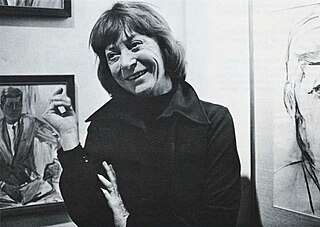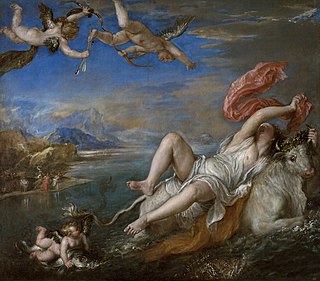Related Research Articles

Helen Frankenthaler was an American abstract expressionist painter. She was a major contributor to the history of postwar American painting. Having exhibited her work for over six decades, she spanned several generations of abstract painters while continuing to produce vital and ever-changing new work. Frankenthaler began exhibiting her large-scale abstract expressionist paintings in contemporary museums and galleries in the early 1950s. She was included in the 1964 Post-Painterly Abstraction exhibition curated by Clement Greenberg that introduced a newer generation of abstract painting that came to be known as color field. Born in Manhattan, she was influenced by Greenberg, Hans Hofmann, and Jackson Pollock's paintings. Her work has been the subject of several retrospective exhibitions, including a 1989 retrospective at the Museum of Modern Art in New York City, and been exhibited worldwide since the 1950s. In 2001, she was awarded the National Medal of Arts.

Georgia Totto O'Keeffe was an American modernist painter and draftswoman whose career spanned seven decades and whose work remained largely independent of major art movements. Called the "Mother of American modernism", O'Keeffe gained international recognition for her meticulous paintings of natural forms, particularly flowers and desert-inspired landscapes, which were often drawn from and related to places and environments in which she lived.

Andrew Newell Wyeth was an American visual artist, primarily a realist painter, working predominantly in a regionalist style. He believed he was also an abstractionist, portraying subjects in a new, meaningful way. The son of N. C. Wyeth and father of Jamie Wyeth, he was one of the best-known U.S. artists of the middle 20th century. James H. Duff explores the art and lives of the three men in An American Vision: Three Generations of Wyeth Art. Raised with an appreciation of nature, Wyeth took walks that fired his imagination. Henry David Thoreau, Robert Frost, and King Vidor's The Big Parade (1925) inspired him intellectually and artistically. Wyeth featured in a documentary The Metaphor in which he discussed Vidor's influence on the creation of his works of art, like Winter 1946 and Portrait of Ralph Kline. Wyeth was also inspired by Winslow Homer and Renaissance artists.

Elaine Marie Catherine de Kooning was an Abstract Expressionist and Figurative Expressionist painter in the post-World War II era. She wrote extensively on the art of the period and was an editorial associate for Art News magazine.

Alice Baber was an American abstract expressionist painter who worked in oil and watercolor. She was educated in the United States and in the 1950s and 1960s she studied and lived in Paris. She also traveled around the world. Baber, a feminist, organized exhibits of women artists' work.

Jane Peterson (1876–1965) was an American Impressionist and Expressionist painter. Her works use broad swaths of vibrant colors to combine an interest in light and in the depiction of spontaneous moments. She painted still lives, beach scenes along the Massachusetts coast, and scenes from her extensive travels. Her works are housed in museums such as the Metropolitan Museum of Art, the Museum of the City of New York, the National Museum of Women in the Arts and the Hirshhorn Museum in Washington D.C., and the Pennsylvania Academy of the Fine Arts and the Philadelphia Museum of Art in Philadelphia, Pennsylvania. She was a fellow of the National Academy of Design and taught at the Art Students League from 1913 to 1919. During her lifetime, Peterson was featured in more than 80 one-woman exhibitions.

Alma Woodsey Thomas was an African-American artist and teacher who lived and worked in Washington, D.C., and is now recognized as a major American painter of the 20th century. Thomas is best known for the "exuberant", colorful, abstract paintings that she created after her retirement from a 35-year career teaching art at Washington's Shaw Junior High School.
Tomma Abts is a German-born visual artist known for her abstract oil paintings. Abts won the Turner Prize in 2006. She currently lives and works in London, England.

Alice Schille (1869–1955) was an American watercolorist and painter from Columbus, Ohio. She was renowned for her Impressionist and Post Impressionist paintings, which usually depicted scenes featuring markets, women, children, and landscapes. Her ability to capture the character of her subjects and landscapes often resulted in her winning the top prize in art competitions. She was also known for her versatility in painting styles; her influences included the “Dutch Old Masters, James McNeill Whistler, the Fauves, and Mexican muralists.” Her estate is represented by Keny Galleries in Columbus, OH.

Emma Lampert Cooper was a painter from Rochester, New York, described as "a painter of exceptional ability". She studied in Rochester, New York; New York City under William Merritt Chase, Paris at the Académie Delécluse and in the Netherlands under Hein Kever. Cooper won awards at several World's Expositions, taught art and was an art director. She met her husband, Colin Campbell Cooper in the Netherlands and the two traveled, painted and exhibited their works together.

Dorothea Rockburne DFA is an abstract painter, drawing inspiration primarily from her deep interest in mathematics and astronomy. Her work is geometric and abstract, seemingly simple but very precise to reflect the mathematical concepts she strives to concretize. "I wanted very much to see the equations I was studying, so I started making them in my studio," she has said. "I was visually solving equations." Rockburne's attraction to Mannerism has also influenced her work.

Elizabeth Nourse was a realist-style genre, portrait, and landscape painter born in Mt. Healthy, Ohio, in the Cincinnati area. She also worked in decorative painting and sculpture. Described by her contemporaries as "the first woman painter of America" and "the dean of American woman painters in France and one of the most eminent contemporary artists of her sex," Nourse was the first American woman to be voted into the Société Nationale des Beaux-Arts. She also had the honor of having one of her paintings purchased by the French government and included in the Luxembourg Museum's permanent collection. Nourse's style was described by Los Angeles critic Henry J. Seldis as a "forerunner of social realist painting." Some of Nourse's works are displayed at the Cincinnati Art Museum.
Cristina Vergano is an Italian-born fine artist and designer living in New York City. Her classical, academic painting style offsets the highly imaginative content of her work. A playful, surreal vein runs through the artist's work, along with a subtle feminist concern and a wink to Pop art. Vergano's paintings have varied subject matter and can be populated with human-animal hybrid creatures, Muslim women in lingerie, flying saucers, word games, and amused references to images by historical artists.

The Helga Pictures are a series of more than 268 paintings and drawings of German model Helga Testorf created by American artist Andrew Wyeth between 1971 and 1985.

Jennie Augusta Brownscombe was an American painter, designer, etcher, commercial artist, and illustrator. Brownscombe studied art for years in the United States and in Paris. She was a founding member, student and teacher at the Art Students League of New York. She made genre paintings, including revolutionary and colonial American history, most notably The First Thanksgiving held at Pilgrim Hall in Plymouth, Massachusetts. She sold the reproduction rights to more than 100 paintings, and images of her work have appeared on prints, calendars and greeting cards. Her works are in many public collections and museums. In 1899 she was described by New York World as "one of America's best artists."

Barbara Ernst Prey is an American artist who specializes in the art of watercolor. In 2008 Prey was appointed to the National Council on the Arts, the advisory body of the National Endowment for the Arts. In 2015, MASS MoCA commissioned Barbara Prey to create the world's largest known watercolor painting for its new Building 6, which opened in Spring 2017. She has worked in oil painting and illustration, the latter of which she contributed to The New Yorker for a decade. She currently works and lives in Long Island, New York, Maine and Williamstown, Massachusetts.
Laura Owens is an American painter, gallery owner and educator. She emerged in the late 1990s from the Los Angeles art scene. She is known for large-scale paintings that combine a variety of art historical references and painterly techniques. She lives and works in Los Angeles, California.

MadC is a graffiti writer and muralist. She was born in Bautzen, Germany, and is most known for her large-scale, outdoor artistic paintings.

The Rape of Europa is a painting by the Venetian artist Titian, painted ca. 1560–1562. It is in the permanent collection of the Isabella Stewart Gardner Museum of Boston, Massachusetts. The oil-on-canvas painting measures 178 by 205 centimetres.

Inez Harrington Whitfield was an educator and botanical illustrator best known for her watercolor paintings of wildflowers native to Arkansas.
References
- ↑ Leonard Tourne Gallery (August 2012). "Sonja Eisenberg Spring". Behance. Retrieved 18 August 2015.
- 1 2 3 4 5 Gardner Jr., Ralph (3 October 2012). "Choosing Brightness Over Despair". The Wall Street Journal. Retrieved 18 August 2015.
- 1 2 3 Yoakam, Anna. "Sonja Eisenberg - from Penniless to Penthouse". The Daily Tuna Blog Spot. Retrieved 18 August 2015.
- 1 2 "Selected Critical Assessments" (PDF). Sonja Eisenberg. Retrieved 18 August 2015.
- 1 2 3 4 "Sonja Eisenberg Resume" (PDF). Sonja Eisenberg. Retrieved 18 August 2015.